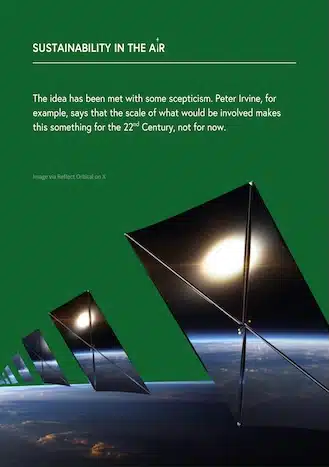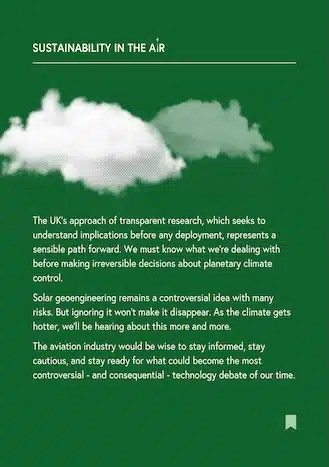REPORT
Solar Geoengineering, Aviation
and the Future of Climate Control
Solar Geoengineering, Aviation
and the Future of Climate Control
This explainer breaks down solar geoengineering, from volcanic models to stratospheric aerosol injection, and examines aviation’s role in climate intervention.
Where do we stand?
In 1991, a volcano in the Philippines changed the world’s climate. Mt. Pinatubo blasted five cubic kilometres of rock and ash into the sky. More importantly, it injected 20 million tonnes of sulphur dioxide into the stratosphere.
The effect? A global temperature drop of up to 0.7°C, lasting over two years. This example of climate intervention is now a template for one of the most controversial climate ideas in the world.
Solar geoengineering envisions replicating the cooling effect of volcanic eruptions by injecting aerosols like sulphur dioxide (SO2) into the upper atmosphere. Its advocates say that if done in a precise and controlled manner, it could slow global warming for a decade or more.
Whether you love or hate the idea, one thing is clear: Solar geoengineering is no longer science fiction. It’s a real, fast-moving field, and you will hear much more about it as the planet warms.
This guide explains solar geoengineering, why it matters now, and where aviation fits in.





Key takeaways
Replicating Volcanoes
Solar geoengineering proposes mimicking volcanic eruptions by injecting sulphur dioxide (SO₂) into the stratosphere to reflect sunlight and cool the planet.
Aviation as Delivery System
Modified aircraft, from business jets to Boeing 777s, could be equipped with sulphur tanks and nozzles, making aviation the primary tool for deployment.
Controversy & Risks
Solar geoengineering could slow warming, but carries serious risks including termination shock, geopolitical conflict, and reputational challenges.
